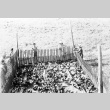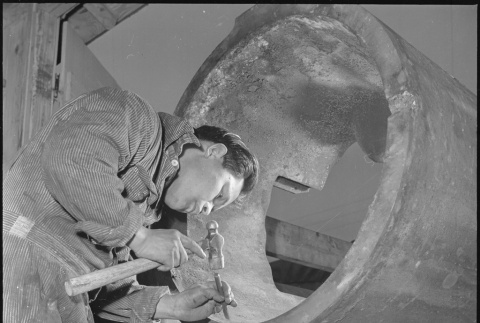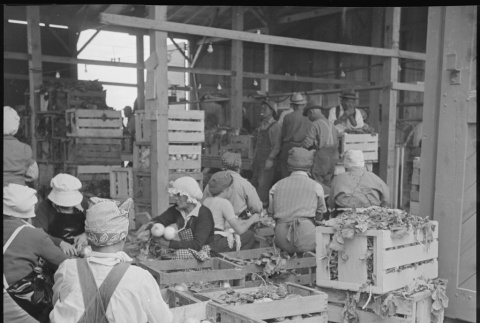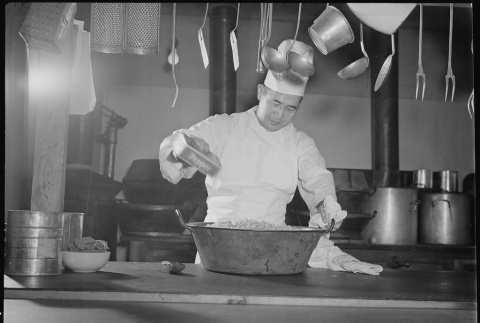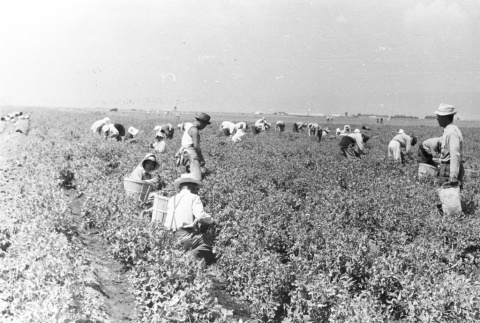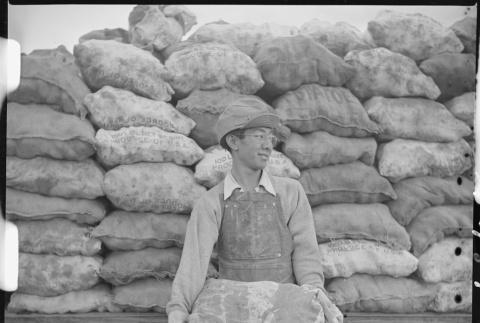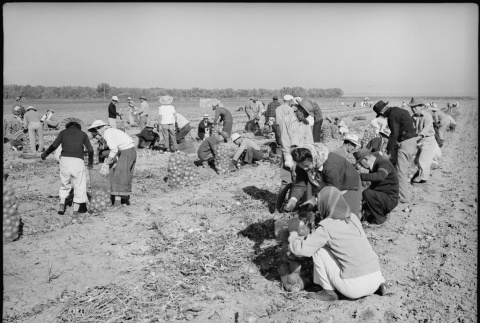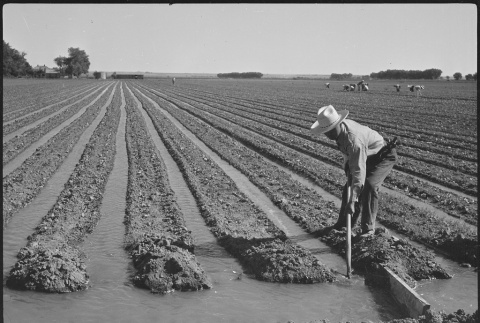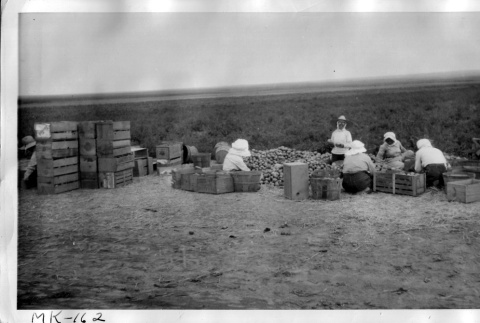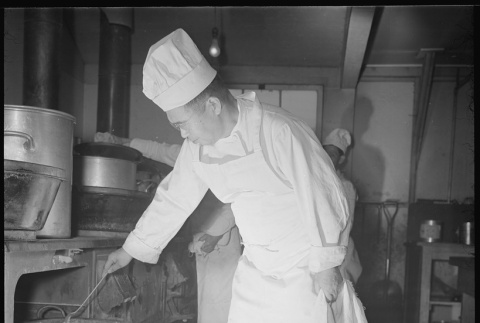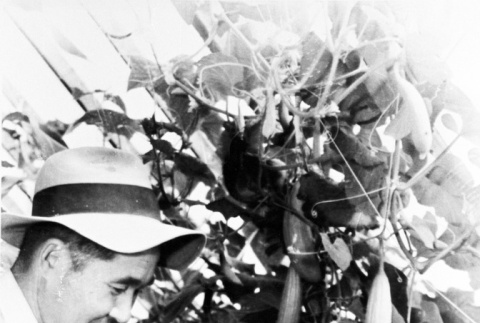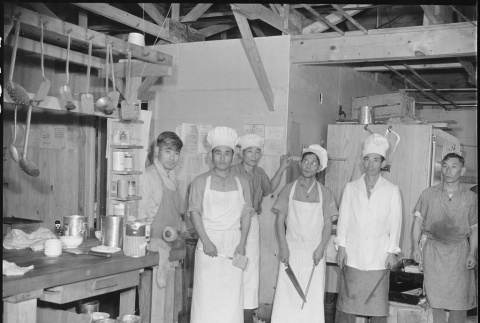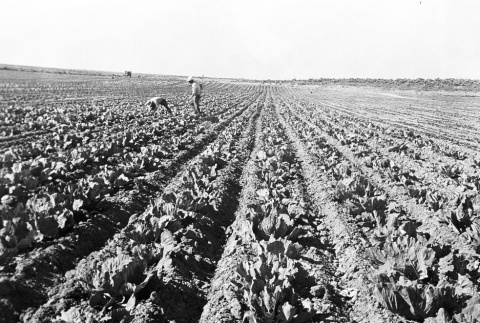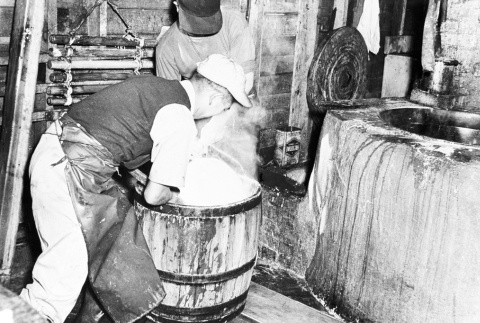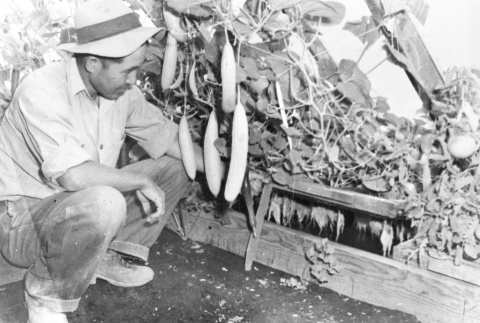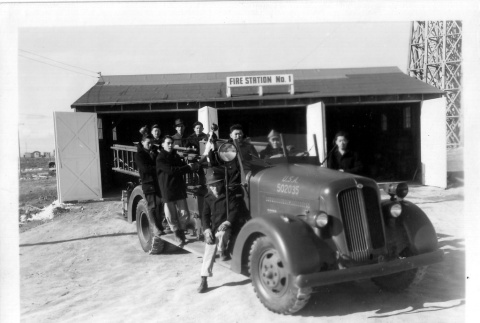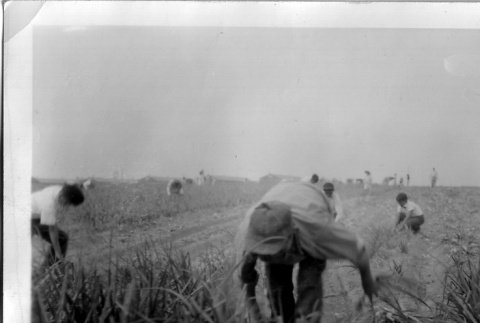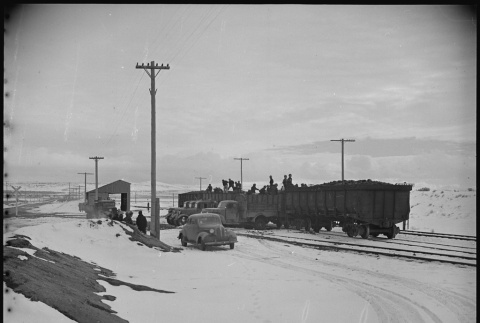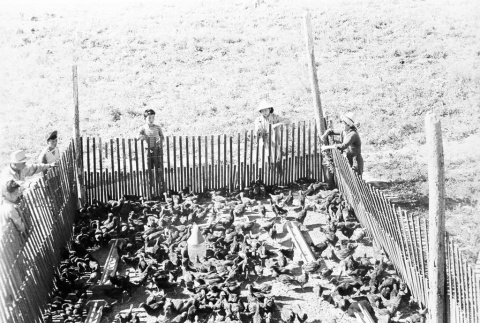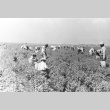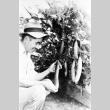Work and jobs
Both Issei and Nisei took jobs within the camps, at wages set not to exceed soldiers' pay: $12 per month for unskilled labor, $16 for skilled labor, and $19 for professional employees. WRA staff was paid much more for the same jobs. Though public opinion mandated such low pay, dissatisfied Japanese Americans objected to losing their right to make a decent living. They had to use their sparse income for necessities, such as warm clothing and shoes.
World War II
(231)
Concentration camps
(1454)
Work and jobs
(1374)
Related articles from the
Densho Encyclopedia :
Amache Silk Screen Shop
1374 items
1374 items
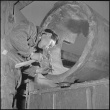
img
Japanese American plumber (ddr-densho-37-540)
Original WRA caption: Rohwer Relocation Center, McGehee, Arkansas. Morio Higashi, a former California plumber, marks out a steel casting for welding. The maintenance of center plumbing, electrical and water supply facilities are carried on by qualified workers selected from center residents, former west coast persons of Japanese ancestry.
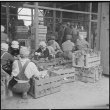
img
Japanese Americans sorting turnips (ddr-densho-37-315)
Original WRA caption: Tule Lake Relocation Center, Newell, California. Evacuee workers in the packing shed, sorting and packing turnips which have been grown on the farm near this relocation center.
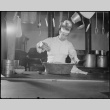
img
Japanese American preparing lunch (ddr-densho-37-330)
Original WRA caption: Dave K. Yoshida, from Seattle, Washington former Chef for Benjamin Franklin Hotel. Kitchen crew preparing lunch. Menu: Baked macaroni with Spanish sauce, spinach, pickled beets, bread-pudding, tea, bread & butter.
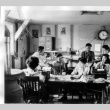
img
Newspaper office workers (ddr-densho-37-687)
Original WRA caption: A group of part time high school student workers in project newspaper office.
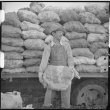
img
Farmer loading potatoes (ddr-densho-37-84)
Original WRA caption: An evacuee farmer ready to put a sack of newly dug potatoes on the truck at the farm at this relocation center.
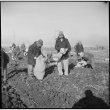
img
Japanese American farmers digging potatoes (ddr-densho-37-87)
Original WRA caption: Evacuee farmers at this relocation center filling sacks with newly dug potatoes.
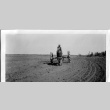
img
Japanese Americans clearing land (ddr-densho-37-705)
Original WRA caption: A tractor draw harrow prepares the soil of a new field cleared out of sagebrush adjacent to the Minidoka Relocation Center.
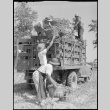
img
Harvesting mustard (ddr-densho-37-528)
Original WRA caption: Rohwer Relocation Center, McGehee, Arkansas. Residents of the Rohwer Relocation Center harvest a truck load of mustard on the extensive acreage they have helped cultivate near-by.

img
Japanese Americans harvesting onions (ddr-densho-37-510)
Original WRA caption: Granada Relocation Center, Amache, Colorado. Evacuee and appointed personnel office workers assisting in the onion harvest on the project farm during the volunteer farm harvest program. During the two week period when practically all project offices and sections went "all out" to help bring in the farm crops, more than eighty acres of …

img
Japanese American auto mechanics (ddr-densho-37-542)
Original WRA caption: Rohwer Relocation Center, McGehee, Arkansas. In the center motor pool shop, George Kenotsu and George Baba, former Stockton, California mechanics, prepare to remove an automobile motor for overhaul. Mechanical repairs to all center motor equipment is carried out by residents, former west coast persons of Japanese ancestry.
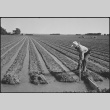
img
Japanese American working on farm (ddr-densho-37-780)
Original WRA caption: Granada Relocation Center, Amache, Colorado. Irrigating thinned lettuce on the project farm.
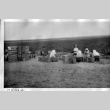
img
Japanese Americans sorting tomatoes (ddr-densho-37-713)
Original WRA caption: A crew of evacuee women sorts tomatoes at the edge of a field which was covered with sagebrush six months before. Because of frequent outcroppings of lava the fields on the project farm are small.
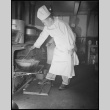
img
Japanese Americans preparing lunch (ddr-densho-37-331)
Original WRA caption: Dave K. Yoshida, from Seattle, Washington former Chef for [the] Benjamin Franklin Hotel. Kitchen crew preparing lunch. Menu: Baked macaroni with Spanish sauce, spinach, pickled beets, bread-pudding, tea, bread & butter.
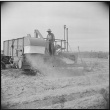
img
Japanese Americans threshing peas (ddr-densho-37-594)
Original WRA caption: Gila River Relocation Center, Rivers, Arizona. Threshing green eating peas for seed. Eleven acres of peas are grown here for their seed, and yield 10 to 12 sacks per acre. This is an extremely high yield.
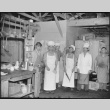
img
Camp kitchen crew (ddr-densho-37-619)
Original WRA caption: Jerome Relocation Center, Denson, Arkansas. The Block 7 kitchen crew pauses for a picture in the early afternoon.
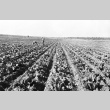
img
Cabbage field (ddr-densho-37-48)
Original WRA caption: Cabbage field. Many incarceration camps raised livestock such as chickens and pigs, as well as vegetables, for camp consumption.
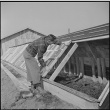
img
Japanese American preparing vegetable hot beds (ddr-densho-37-626)
Original WRA caption: Jerome Relocation Center, Denson, Arkansas. A young farm assistant preparing hot beds at the Jerome Center, where former west coast residents of Japanese ancestry now reside. The center farm activities will include the raising of any vegetable for center use.
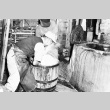
img
Japanese Americans making tofu (ddr-densho-37-156)
Original WRA caption: The cooked beans are poured into a fine-meshed sack and water is added. Squeezing the sack the fiberous substance is held back and the rest of the precipitate is squeezed into a barrel. Into this strained mash or curd, brine is added to cause it to precipitate. This factory is operated by the …
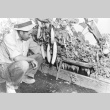
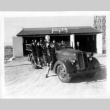
img
Fire crew (ddr-densho-37-693)
Original WRA caption: The fire crew of station #1 swings into action.

img
Japanese Americans working in a field (ddr-densho-37-709)
Original WRA caption: Junior High School boys and girls of Hunt pull onions on the project farm during harvest vacation.
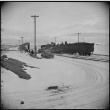
img
Japanese Americans unloading coal (ddr-densho-37-348)
Original WRA caption: Tule Lake Relocation Center, Newell, California. Evacuee workers unload coal at Staley Junction, which is the rail head for this center. This coal is used by the residents during the extreamely [sic] cold winters which northern California offers.
